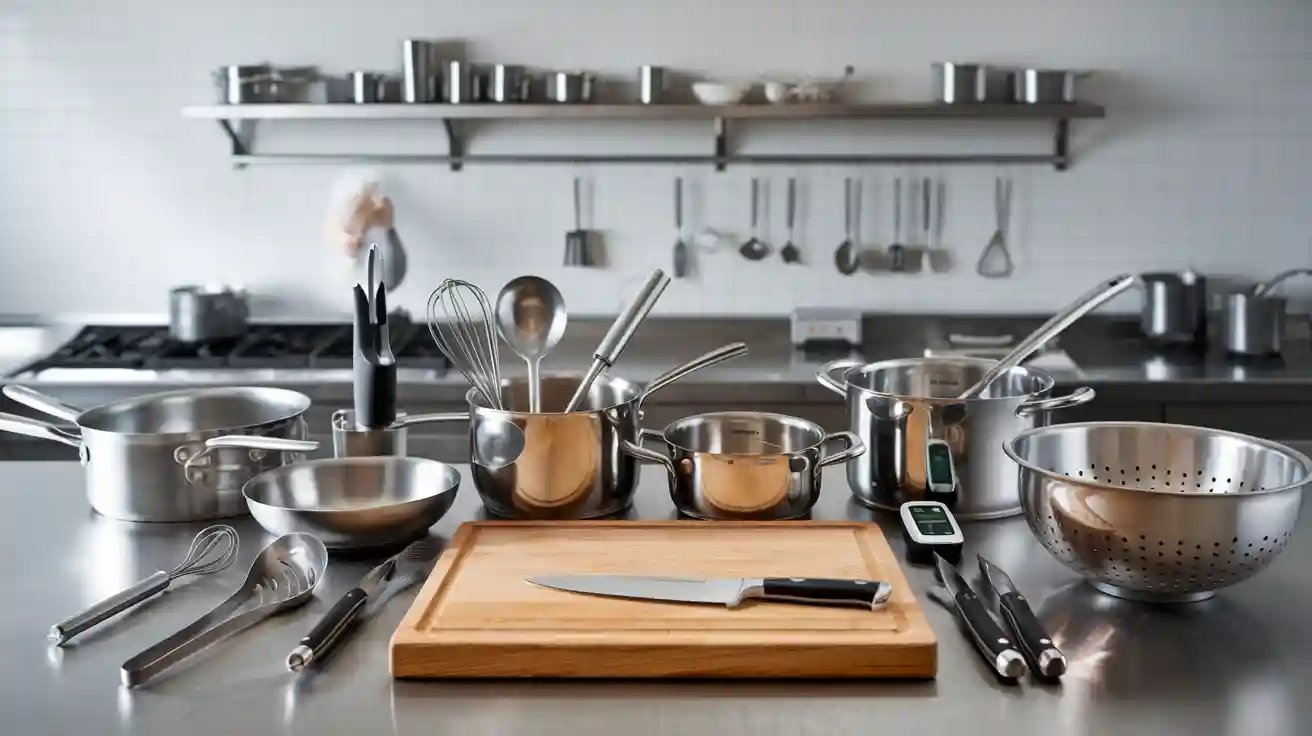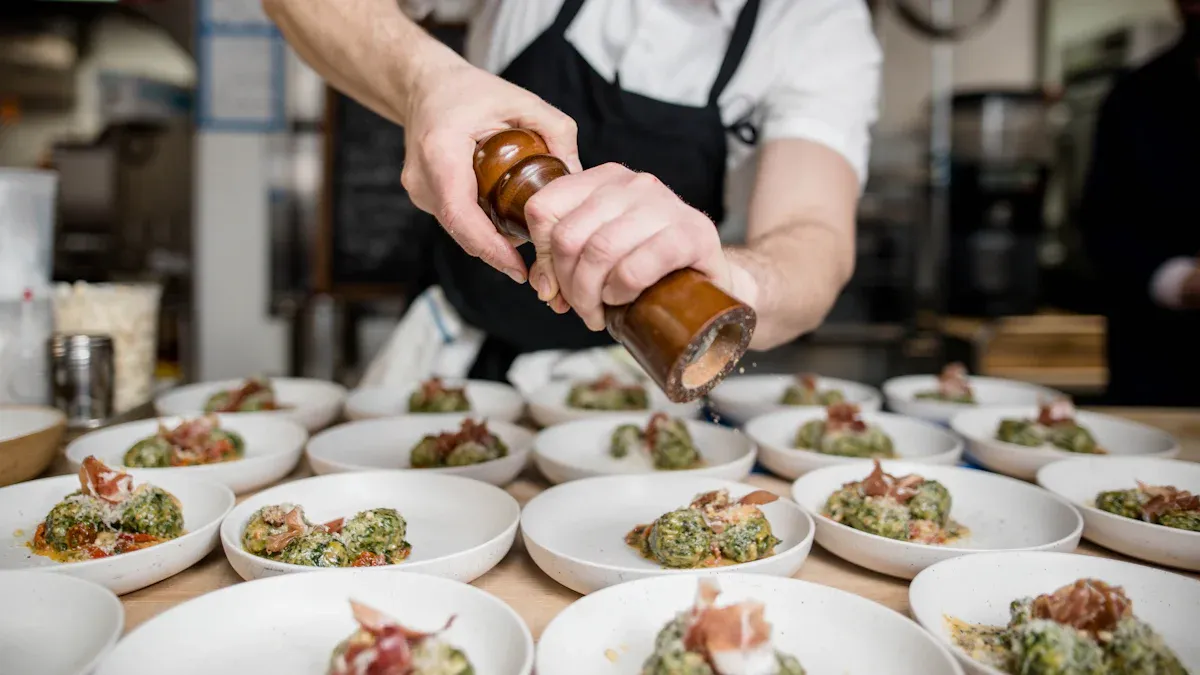
You rely on the right cooking tools and equipment to keep your restaurant kitchen running smoothly. Restaurant kitchen equipment stands at the core of every kitchen equipment list and restaurant equipment checklist. When you prepare meals, restaurant kitchen equipment ensures each step remains efficient. Cooking tools and equipment help you maintain consistency in your restaurant kitchen. Restaurant kitchen equipment supports every cooking task in your restaurant kitchen. The kitchen equipment list and restaurant equipment checklist guide you as you select equipment for your restaurant kitchen. Cooking equipment keeps your kitchen organized and productive. Restaurant kitchen equipment allows your restaurant to deliver quality cooking every day. The kitchen equipment list and restaurant equipment checklist make sure your restaurant kitchen never misses essential equipment. Cooking equipment gives your kitchen the power to perform at a professional chef level.
Prep Tools for Professional Chefs
Chef’s Knives and Specialty Blades
You need the right knives to work efficiently in a restaurant kitchen. A chef’s knife stands as the backbone of your essential kitchen tools. You use it for chopping, slicing, and dicing almost every ingredient. Many chefs also rely on a boning knife for tasks like trimming meat or filleting fish. Specialty blades, such as paring knives and serrated bread knives, help you handle specific jobs with precision.
- Knife sets tested in real kitchens focus on sharpness, durability, and versatility.
- Sharpness lets you cut both delicate and tough foods with ease.
- Durability ensures your knives last through repeated use.
- Versatility means you can handle a wide range of kitchen tasks.
You should choose blades made from stainless steel for rust resistance or carbon steel for superior sharpness. Precision-forged blades give you strength and reliability. Ergonomic handles reduce strain and improve control, which helps you work longer without discomfort. Top brands like Shun Premier and Miyabi Kaizen receive high marks for sharpness, edge retention, and comfort. You should hand wash and hone your knives regularly to keep them in top shape. A boning knife, in particular, gives you the control needed for detailed butchery work.
Tip: Use a boning knife for removing bones from meat and fish. Its narrow blade gives you accuracy and reduces waste.
Cutting Boards and Food Prep Counters
Cutting boards and food prep counters form the foundation of safe and efficient food preparation in every restaurant. You should use color-coded cutting boards—red for raw meat, green for vegetables, and other colors for different foods. This system helps you avoid cross-contamination and keeps your kitchen safe.
- Color-coded boards act as visual cues for your staff.
- Designated food prep counters for different food types lower contamination risks.
- Training your team to use the correct boards and sanitize them between uses is crucial.
You need sturdy food prep counters that can handle heavy use. Stainless steel counters resist stains and bacteria, making them ideal for restaurant kitchens. You should always keep your food prep counters clean and organized to speed up your workflow.
Peelers, Graters, and Mandolines
You use peelers, graters, and mandolines to prepare ingredients quickly and evenly. A sharp peeler lets you remove skins from fruits and vegetables with minimal waste. Graters help you shred cheese, zest citrus, or grate vegetables for salads. Mandolines give you uniform slices, which is important for presentation and even cooking.
A boning knife can also help with detailed prep work, such as removing silver skin from meat. These kitchen tools and gadgets save you time and improve consistency in your dishes.
Mixing Bowls and Prep Containers
Mixing bowls and prep containers keep your ingredients organized and ready for cooking. You need bowls in different sizes for mixing batters, tossing salads, or marinating meats. Prep containers let you store chopped vegetables, sauces, and other ingredients until you need them.
Choose containers with tight-fitting lids to keep food fresh. Clear containers help you see what’s inside, which speeds up your workflow. You should label your containers to avoid confusion and maintain food safety.
Measuring Cups, Spoons, and Kitchen Scales
Accurate measurements are vital in a restaurant kitchen. You use measuring cups and spoons for dry and liquid ingredients. A kitchen scale gives you precise weights, which is important for baking and portion control.
You should choose sturdy, easy-to-clean measuring tools. Digital kitchen scales offer quick and accurate readings. These essential tools help you maintain consistency in every dish you serve.
Bench Scrapers and Dough Scrapers
Bench scrapers and dough scrapers are versatile kitchen tools and gadgets. You use them to divide dough, scrape food prep counters, and transfer chopped ingredients. A bench scraper helps you keep your workspace clean and organized.
A dough scraper is especially useful when working with bread or pastry dough. It lets you lift and fold dough without sticking. You can also use a boning knife to trim dough or cut pastry with precision.
Note: Keeping your food prep counters clean with a bench scraper reduces mess and speeds up your prep work.
You rely on these cooking tools and equipment every day. They form the backbone of your restaurant kitchen and help you deliver high-quality results. By investing in the right kitchen tools and gadgets, you set yourself up for success in every cooking task.
Essential Restaurant Cooking Equipment
Cookware: Pans, Pots, and Skillets
You need reliable cookware to handle the demands of a busy restaurant kitchen. Pans, pots, and skillets form the backbone of your daily operations. Stainless steel pans give you durability and even heat distribution. Nonstick skillets help you cook delicate foods like eggs and fish without sticking. Heavy-duty stock pots allow you to simmer soups, boil pasta, or prepare large batches of sauces.
You should invest in cookware that withstands high temperatures and frequent use. Look for riveted handles and thick bases. These features help you avoid warping and ensure safety. Cast iron skillets offer excellent heat retention, making them perfect for searing meats or finishing dishes in the oven. Copper pans provide precise temperature control, which is essential for sauces and reductions.
Tip: Rotate your cookware regularly to extend its lifespan and maintain even wear.
Ovens, Ranges, and Commercial Work Tables
Ovens and ranges stand at the heart of every restaurant kitchen. You rely on these pieces of restaurant kitchen equipment to deliver consistent results, whether you bake, roast, or broil. Commercial ovens come in many types, including convection, deck, and combi ovens. Each type supports different cooking methods and menu needs. Ranges give you the flexibility to sauté, simmer, or boil with multiple burners.
Industry reports show that the global commercial oven market is projected to grow from USD 10.5 billion in 2023 to USD 20.0 billion by 2033. This growth reflects the demand for advanced cooking technologies that boost efficiency, food quality, and energy savings in restaurants. Companies like Alto-Shaam and Duke Manufacturing have introduced ovens that cook food up to 40% faster and reduce energy use by 15%. These innovations help you serve more guests while saving on costs.
The U.S. range cooker market is also expanding, driven by rising restaurant sales and the popularity of modular kitchens. Larger range cookers give you versatile functions and high performance, which are crucial for a commercial kitchen. The global commercial cooking equipment market, valued at USD 13.04 billion in 2023, continues to grow as restaurants seek energy-efficient, smart, and modular equipment to improve kitchen performance and sustainability.
Commercial work tables provide sturdy surfaces for prep and plating. Stainless steel tables resist corrosion and are easy to clean. You can organize your workflow by placing work tables near ovens and ranges, reducing movement and saving time.
Note: Arrange your work tables to create efficient stations for prep, cooking, and plating.
Cooking Utensils: Spatulas, Tongs, Ladles, and Whisks
You depend on high-quality utensils to speed up dish preparation and maintain consistency. Spatulas help you flip, spread, or scrape with precision. Tongs allow you to turn meats or serve salads without damaging delicate ingredients. Ladles make portioning soups and sauces easy. Whisks blend batters and emulsify dressings quickly.
Market analysis shows that demand for ergonomic and multifunctional utensils is rising. Busy lifestyles and the growth of home chefs have increased the need for tools that make cooking faster and more accurate. Innovations like ergonomic handles and smart kitchen compatibility further improve your efficiency. The right utensils help you deliver dishes on time and keep your kitchen running smoothly.
| Utensil | Primary Use | Key Feature |
|---|---|---|
| Spatula | Flipping, spreading | Heat-resistant handle |
| Tongs | Turning, serving | Locking mechanism |
| Ladle | Portioning liquids | Deep bowl |
| Whisk | Mixing, emulsifying | Balloon shape |
Pro Tip: Choose utensils made from stainless steel or heat-resistant silicone for durability and safety.
Thermometers and Timers
You must ensure food safety and precise cooking times in your restaurant kitchen. Thermometers give you accurate temperature readings, which visual cues cannot guarantee. An instant-read thermometer helps you check if meats and other foods reach safe internal temperatures. The USDA found that 21% of people rely on color or grill marks to judge doneness, but only thermometers can confirm safety.
Thermometers in a commercial kitchen should cover a wide temperature range, be durable, and offer quick response times. Timers with multiple channels, clear displays, and loud alarms help you manage several dishes at once. These features support compliance with food safety regulations and keep your kitchen efficient. Timers prevent undercooking or overcooking, which protects your guests and your reputation.
Always calibrate your thermometers and test your timers before each shift.
Fine-Mesh Strainers and Colanders
You use fine-mesh strainers and colanders to separate solids from liquids and rinse ingredients. Fine-mesh strainers help you achieve smooth sauces, clear broths, and lump-free batters. Colanders allow you to drain pasta, wash vegetables, or cool blanched foods quickly.
Choose strainers with sturdy handles and reinforced rims. Stainless steel models resist rust and last longer in a busy restaurant kitchen. Stackable colanders save space and make storage easier. These pieces of restaurant kitchen equipment help you maintain quality and speed during service.
Note: Keep several sizes of strainers and colanders on hand to handle different tasks efficiently.
Plating and Finishing Tools for Restaurant Kitchens

Plating Tweezers and Precision Tongs
You use plating tweezers and precision tongs to add the final touches to your dishes. These tools help you place microgreens, herbs, or edible flowers exactly where you want them. In a busy restaurant, you need accuracy and speed. Plating tweezers give you control over small ingredients. Precision tongs let you handle delicate foods without damaging them. Many chefs in top restaurants rely on these tools to create beautiful presentations that impress guests.
Tip: Keep your plating tweezers and tongs clean and dry. This prevents cross-contamination and keeps your restaurant kitchen safe.
Offset Spatulas and Spoons
Offset spatulas and spoons help you spread sauces, lift delicate items, and create smooth surfaces on plates. You use an offset spatula to move cakes or fish fillets without breaking them. Spoons allow you to drizzle sauces or create decorative swirls. In a restaurant, these tools help you achieve consistency in every dish. You can use different sizes for different plating needs. Offset spatulas and spoons make your plating process faster and more precise.
| Tool | Main Use | Benefit in Restaurant |
|---|---|---|
| Offset Spatula | Lifting, spreading | Prevents breakage |
| Plating Spoon | Drizzling, swirling | Adds visual appeal |
Squeeze Bottles and Brushes
Squeeze bottles and brushes let you add sauces, oils, or purees with accuracy. You use squeeze bottles to draw lines or dots on plates. Brushes help you paint sauces or glazes for a creative finish. In a restaurant, these tools save time and reduce waste. You can prepare several bottles with different sauces before service. Squeeze bottles and brushes help you keep your plating area organized and efficient. These cooking tools and equipment support your creativity and consistency in every restaurant kitchen.
Note: Label your squeeze bottles to avoid confusion during busy restaurant service.
Must-Have Restaurant Kitchen Equipment and Appliances
Food Processors and Immersion Blenders
You need food processors and immersion blenders in your restaurant kitchen equipment lineup. These pieces of equipment help you handle prep work quickly and consistently. Food processors chop, slice, and puree ingredients in seconds. Immersion blenders let you blend soups or sauces right in the pot. You save time and reduce labor costs by automating repetitive tasks. Your restaurant benefits from uniform textures and precise cuts, which improve both presentation and cooking results.
The following table shows how these tools boost efficiency and consistency in your restaurant:
| Performance Metric | Description |
|---|---|
| Time Savings | Food processors reduce prep time by half or more by automating repetitive tasks. |
| Textural Consistency | Uniform chopping, slicing, pureeing ensures consistent texture, affecting cooking time and presentation. |
| Labor Cost Optimization | Automation reduces labor dependency by handling repetitive prep tasks. |
| Food Waste Reduction | Precision cutting and portioning minimize waste and mess. |
| Consistent Cooking Results | Immersion circulators maintain precise temperatures and circulate water to avoid overcooking. |
| Automation Features | Programmable presets and controls remove manual variability, ensuring uniformity and efficiency. |
You keep your restaurant kitchen equipment running smoothly by choosing models with programmable settings and easy-to-clean parts. These tools help your restaurant maintain high standards and meet the demands of busy service.
Stand Mixers and Hand Mixers
You rely on stand mixers and hand mixers to handle mixing tasks in your restaurant. These pieces of equipment give you control over dough quality and batter consistency. Stand mixers let you adjust speed and mixing time, which makes your process more scientific and reliable than manual mixing. Built-in timers allow you to multitask, so you can focus on other jobs while the mixer works.
Commercial mixers support high-volume production in your restaurant kitchen. They reduce manual labor and help you deliver consistent results every time. The table below outlines the main types of mixers you might use in your restaurant:
| Mixer Type | Typical Use Case | Size/Capacity | Cost Range | Maintenance Requirements | Lifespan | Power Requirements |
|---|---|---|---|---|---|---|
| Hand Mixers | Small tasks, light-duty mixing | Lightweight, 10-15 in | $50 – $400 | Clean beaters, inspect cord and motor casing | 3-5 years | 120V, 150-350W |
| Countertop Mixers | Small to medium batch processing | 5-20 quarts | $700 – $2,500 | Clean, lubricate parts, inspect gears | 8-12 years | 120V, 500-1,200W |
| Floor Mixers | Large-volume, heavy dough mixing | 30-80+ quarts | $4,000 – $15,000 | Daily cleaning, lubrication, safety checks | 12-20 years | 208V-240V, often 3-phase |
You keep your restaurant kitchen equipment in top shape by cleaning and maintaining your mixers daily. These mixers help your restaurant handle large orders and keep up with demand, making them essential equipment for any professional kitchen.
Storage and Safety in Professional Kitchens
Food Storage Containers and Shelving
You keep your restaurant kitchen organized and safe by using the right storage containers and shelving. Commercial kitchen operations depend on clear, airtight containers to store ingredients and prepared foods. You rely on commercial refrigerators and freezers to maintain proper temperatures and prevent spoilage. Shelving units help you separate dry goods, canned items, and cleaning supplies. You should always label containers with dates and contents. This practice supports food safety and reduces waste. You protect your kitchen from cross-contamination by storing raw meats below ready-to-eat foods in refrigerators. Regular cleaning of shelving and containers keeps your restaurant kitchen sanitary.
Knife Storage and Safety Equipment
Knife safety remains a top priority in every restaurant kitchen. You use knife racks, magnetic strips, or protective sheaths to store blades securely. Proper storage prevents accidents and keeps knives sharp. Each year, 350,000 people suffer knife injuries in the kitchen. Dull knives increase the risk of injury because they require more force and are harder to control. You reduce accidents by keeping knives sharp and handling them with care. Always use cutting boards on stable surfaces and cut away from your body. Never try to catch a falling knife. You also use oven mitts and pot holders as part of your safety equipment. Keeping these items dry prevents burns and scalds. Avoid placing mitts or towels near stovetops to reduce fire hazards.
- Store knives in racks or on magnetic strips.
- Keep knives sharp for better control.
- Use oven mitts and pot holders for hot equipment.
- Keep safety equipment dry and away from heat sources.
Color-Coded Systems for Hygiene
Color-coded systems help you maintain hygiene in your restaurant kitchen. You assign specific colors to cutting boards, utensils, and storage bins for different food groups. For example, you use red for raw meat, green for vegetables, and blue for seafood. This system reduces the risk of cross-contamination and supports food safety. You train your staff to follow color codes at every station. Commercial kitchen managers often post charts or guides near work areas as reminders. You also use color-coded bins in refrigerators to separate allergens and prevent mix-ups. Consistent use of color-coded equipment keeps your restaurant kitchen compliant with health regulations.
Tip: Review your color-coded system regularly to ensure everyone in your restaurant kitchen follows the correct procedures.
Maintenance Tools for Restaurant Cooking Equipment
Sharpening Stones and Honing Rods
You keep your knives in top condition with sharpening stones and honing rods. Sharp knives help you work faster and safer in your restaurant kitchen. You use a sharpening stone to restore the edge of your blades. Honing rods help you maintain that edge between sharpening sessions. When you care for your knives, you reduce the risk of accidents and improve your cutting accuracy. Many chefs in the restaurant industry sharpen their knives weekly and hone them daily. This routine extends the life of your kitchen equipment and keeps your workflow smooth. You also protect your investment by preventing chips and dullness. Sharp knives make prep work easier and help you deliver consistent results in your restaurant.
Cleaning Supplies and Sanitizers
You rely on cleaning supplies and sanitizers to keep your restaurant kitchen safe and efficient. Daily cleaning of your equipment prevents grease and food debris from building up. You clean ovens and stovetops to avoid fire hazards and maintain cooking efficiency. You check door seals on refrigeration units to keep food at the right temperature. You inspect burners for blockages to ensure proper ignition. You clean dishwasher filters and spray arms for effective sanitization. You scrape grills, griddles, and fryers to prevent residue that can affect food quality. Draining and filtering fryer oil helps you maintain food standards and extend oil life.
- Restaurants spend $28 billion each year on repairs and upkeep, and $35 billion on new equipment. Preventive maintenance saves money and extends the lifespan of your kitchen equipment.
- Proper upkeep improves operational speed and helps you serve guests faster.
- Maintenance supports food quality by ensuring your equipment works as it should.
- Routine cleaning and inspections reduce fire risks and support kitchen safety.
- Clean equipment helps you meet health regulations and avoid food contamination.
You keep your restaurant kitchen running at its best by making maintenance a daily habit. Clean, well-maintained equipment supports every part of your operation.
You build your restaurant’s success on the right kitchen equipment. Quality equipment in your restaurant kitchen reduces wait times and boosts customer satisfaction. Restaurant teams work faster with reliable kitchen equipment. Restaurant owners see fewer repairs and lower costs. Restaurant kitchens stay safe and efficient. Restaurant equipment supports workflow. Restaurant kitchen equipment improves teamwork. Restaurant kitchens meet regulations. Restaurant equipment ensures high standards. Restaurant kitchen equipment drives profitability.
FAQ
What is the most important piece of equipment in a restaurant kitchen?
You need a reliable chef’s knife. This tool supports almost every task in your restaurant kitchen. Quality knives improve speed, safety, and consistency in your kitchen.
How often should you maintain restaurant kitchen equipment?
You should clean and inspect your restaurant kitchen equipment daily. Schedule deep cleaning and professional maintenance monthly. Regular care extends the life of your equipment and keeps your kitchen safe.
Why do restaurants use color-coded kitchen equipment?
You use color-coded equipment in your restaurant kitchen to prevent cross-contamination. This system helps your team follow food safety rules and keeps your kitchen organized and efficient.


